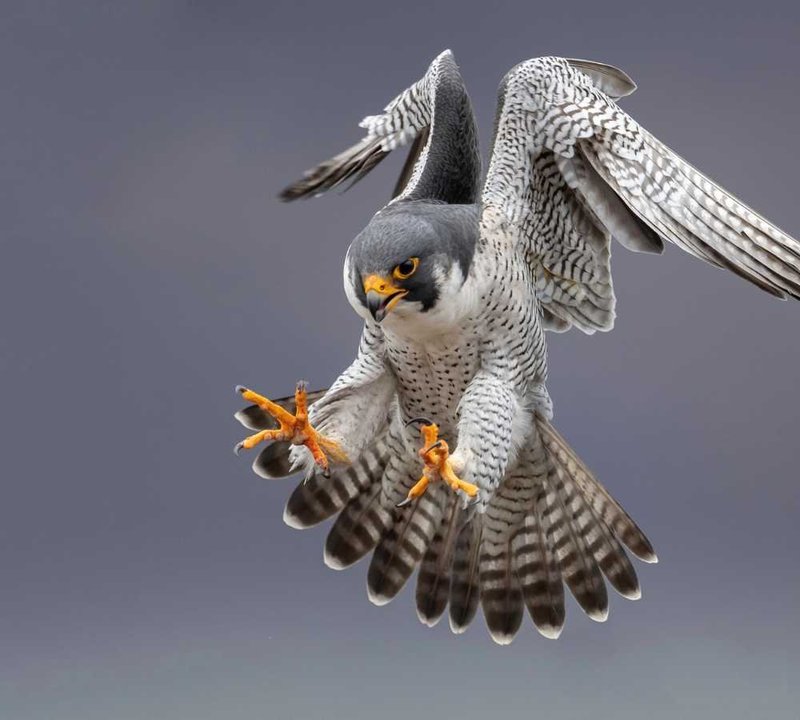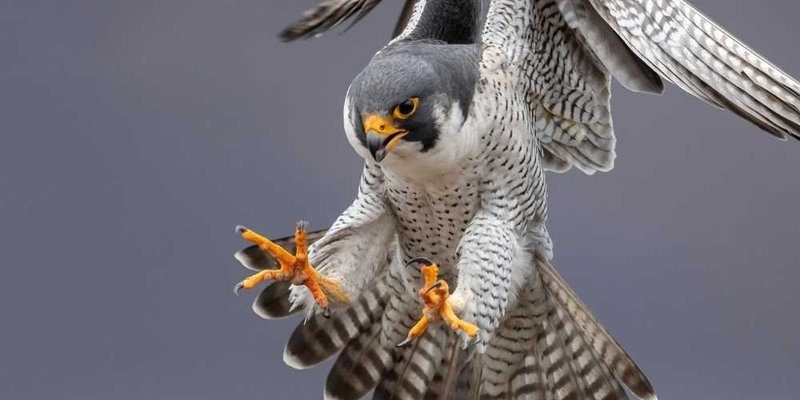
Imagine a skilled athlete who can handle any terrain—be it mountains, urban skyscrapers, or vast deserts. That’s a peregrine falcon for you. These fascinating birds demonstrate resilience and ingenuity, showcasing nature’s brilliance in adapting to climate extremes, food scarcity, and other challenges.
Let’s unpack how peregrine falcons manage to survive and even excel in harsh environments, shaping their behavior and physical traits.
1. Mastering the Skies: Adaptations for Hunting
Peregrine falcons are the ultimate hunters. Their bodies are perfectly designed for speed and precision. From their pointed wings to their streamlined shapes, every feature serves a purpose. When swooping down on prey, they can spot a pigeon from miles away—thanks to their incredible eyesight that’s five to six times sharper than humans.
Their hunting strategy is like a well-coordinated ballet. They often perch high to scan the ground, waiting for the perfect moment to dive. Once they’ve locked onto their target, they tuck in their wings and plunge, reaching mind-boggling speeds. This technique not only helps them catch agile prey but also conserves energy, allowing them to thrive in areas where resources might be limited.
Moreover, their strong talons and beak are built for efficiency. The curved shape of their beak helps them tear into their prey swiftly. This adaptation means they can quickly consume a meal before it gets too cold—vital when food is scarce in their environment.
2. Resilience Against the Elements
Peregrine falcons face various weather conditions, from scorching heat to freezing cold. But they have some impressive adaptations that help them cope. Their feathers aren’t just for looks; they provide excellent insulation. In colder climates, these feathers trap air close to their bodies, keeping them warm while they soar high above freezing temperatures.
Even more fascinating is how these birds manage their body temperature. When it’s hot outside, they can regulate their body heat by altering their posture. Spreading their wings or panting helps them cool down. It’s as if they’ve got a built-in thermostat, an essential trait for survival in extreme weather.
For those living in urban areas, the ability to adapt to human-made environments is just as crucial. Peregrine falcons often nest on tall buildings or cliffs, mimicking their natural habitat. This clever choice helps them stay safe from predators and gives them an ideal vantage point for hunting. It’s incredible how they’ve turned our cities into their playgrounds!
3. Food Sources and Adaptability
What do peregrine falcons eat? You might think only small birds, but their diet is surprisingly diverse. They primarily feed on birds, but during tough times, they can switch things up and eat small mammals or even insects. This kind of dietary flexibility is vital for survival.
Their ability to adapt isn’t just a fluke—it’s a survival tactic. When food is plentiful, they can feast on their favorite meals, but when resources drop, they’re quick to change their hunting strategy. For example, urban falcons might shift from hunting pigeons to scaving for food scraps left by humans.
This adaptability is like having a go-to backup plan. In moments of scarcity, they can rely on their intelligence and resourcefulness to find something to eat. It’s a remarkable trait that allows them to thrive in both cities and the wild.
4. Nesting Strategies in Harsh Environments
Finding a safe place to lay eggs and raise young is crucial for any bird, especially in unforgiving environments. Peregrine falcons choose their nesting sites carefully. They often opt for high cliffs or ledges, which provide safety from predators and harsh weather. In urban areas, they’ve adapted to nesting on buildings or bridges, seamlessly blending into the skyline.
The nests themselves—called eyries—are simple but effective. They’re often just scraped-out depressions on a ledge, lined with small rocks or bits of greenery. This minimalistic approach may seem odd, but it works. The eggs are protected from direct exposure to harsh elements.
During the breeding season, these birds are fiercely protective of their nests. This vigilance ensures that their chicks grow up in a safe environment, ready to take on the world. Watching a parent bird swoop down to protect its young is a testament to their determination and love for their offspring.
5. Communication and Social Structure
Peregrine falcons are not solitary creatures. They communicate through vocalizations and body language, which play a critical role in their social structure. The high-pitched calls help in establishing territory or alerting partners about threats. This connection is vital, especially when raising young.
Interestingly, these birds have a unique way of bonding during courtship. Male peregrine falcons often perform aerial displays to impress potential mates. They dive, swoop, and even pass food to each other—kind of like a dramatic dance in the sky! This behavior not only strengthens their pair bond but also demonstrates their physical prowess.
When it comes to survival, teamwork can be essential. While one parent hunts, the other stays with the young, ensuring their safety. This cooperative approach guarantees that they can raise their chicks successfully, even in challenging environments.
6. Conservation Efforts and Their Impact
Sadly, peregrine falcons faced massive declines due to habitat destruction and pesticide use in the mid-20th century. But thanks to concerted conservation efforts, their populations have rebounded remarkably. Projects focused on habitat protection, breeding programs, and public awareness have all played a role in their comeback.
These efforts remind us of the importance of preserving natural habitats. When we protect the peregrine falcon’s environment, we ensure these incredible birds continue to thrive.
You might be wondering how you can help. Supporting local conservation groups or participating in birdwatching initiatives can make a difference. Every small effort counts towards maintaining the balance of our ecosystems and ensuring these magnificent birds remain part of our world.
7. The Peregrine Falcon: A Symbol of Resilience
In many ways, the peregrine falcon is a symbol of resilience. Their ability to adapt to harsh environments—from urban jungles to rugged cliffs—demonstrates the power of nature’s ingenuity. Watching them soar through the sky is a reminder that survival is about more than just physical strength; it’s also about intelligence and adaptability.
As you observe these magnificent birds from a distance, consider their journey. They endure extreme weather, hunt creatively, and find innovative nesting spots, all while navigating a world that can be unpredictable. It’s a testament to survival and a reminder to us all about the beauty of the natural world.
In summary, the peregrine falcon embodies the essence of survival in harsh environments. Through their adaptations, flexibility, and resilience, they remind us that life can flourish even in the most challenging circumstances. Next time you catch a glimpse of one soaring through your town or in the wild, take a moment to appreciate the journey they’ve made to thrive in our world.

